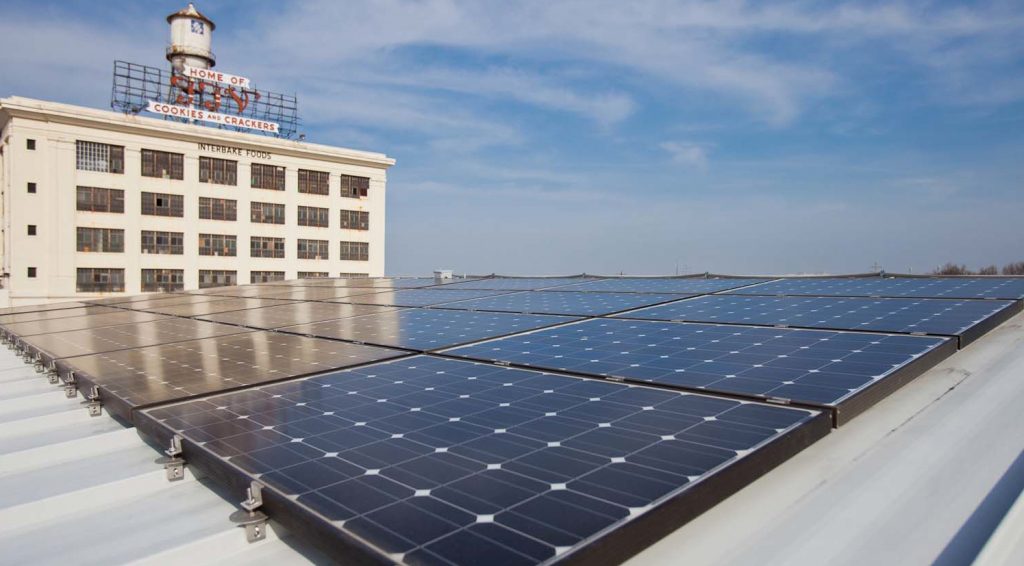A city loan program aimed at enticing property owners to make clean energy and water efficiency upgrades is being put on hold weeks before it was set to start, in light of a state-funded program that could end up replacing it.
Richmond’s first C-PACE program, formally called a Commercial Property Assessed Clean Energy Financing Program, was scheduled to start July 1 after City Council adopted it last fall. City leaders now plan to push back the rollout to make way for a statewide clean energy financing program that was approved in the General Assembly session this spring and likewise is planned for the coming fiscal year.
The city initially planned to repeal the local program via an ordinance that goes before council’s Finance and Economic Development Standing Committee this week, prompting concerns from some clean energy proponents and real estate developers who supported the program.
But a compromise reached Monday between Mayor Levar Stoney and council member Kristen Larson, who co-patroned the program’s enacting legislation, calls for delaying the program’s rather than scrapping it completely, giving the city time to see what the state program looks like and if it adequately replaces the city’s C-PACE.
Larson, who already had a standing meeting scheduled with Stoney, said they agreed to have the ordinance amended to push the start date to March 1, 2021.
That’s nine months later than the program would have started, and with state funding in flux amid the coronavirus pandemic, it’s not yet clear what the state version will involve, or when it would start.
That could mean a lull for property owners and developers who were looking to take advantage of the city’s C-PACE, which was to allow property owners to pursue 30-year loans to help finance clean energy improvements for existing buildings or new construction. But Larson said that’s better than doing away with the program altogether.
“That will give us some time to see if the state pulls their program together or not. If it doesn’t come together, then we still have all the language there to implement the program on the local level,” Larson said.
“I definitely worry about putting it on pause for a couple months, but I’m open to doing it so we’re not duplicating efforts.”
Loans up to $25M
As proposed, the city program would have provided individual loans ranging from $50,000 to $25 million, either through private lenders or public funds approved by council. Eligible properties would include commercial and industrial properties, as well as residential developments exceeding five dwelling units. The program did not include condos and buildings with four or fewer dwelling units.
Improvements funded through the program were to include renewable energy systems such as solar, geothermal, wind and methane recovery, as well as high-efficiency lighting, HVAC upgrades and green roofs. Eligible water usage efficiencies included water recovery, purification, recycling and other conservation techniques. Floodproofing and stormwater improvements also would be eligible.
The state program, authorized by a House bill, is to be developed and administered by a private entity that the Virginia Department of Mines, Minerals and Energy would choose through a competitive selection process.
While the state already promotes the use of PACE and facilitates financing with underwriting guidelines for localities, the program authorized by HB 654 would create a uniform process across the state, relieving localities of the costs of administering their own programs. Such cost savings were cited in the city’s repeal ordinance, which Stoney and administrators signed off on last month.
The proposal riled program supporters such as William Greenleaf, an executive and real estate lending team manager with Virginia Community Capital who is part of an informal PACE stakeholder group consisting of real estate lenders, developers and attorneys.
Greenleaf said the group was concerned that repealing the ordinance would send a bad message to other local governments and have a chilling effect on PACE programs in development. Another concern was the timing of the state program start, particularly amid budget cuts caused by COVID-19.
Preston Lloyd, a local attorney who serves as legislative counsel for the Home Building Association of Richmond, described the delay agreement reached between Larson and Stoney as a political compromise that keeps PACE financing in the cards.
“Given the different priorities that the city is grappling with and the challenges from a budgetary standpoint,” Lloyd said, “this was probably something that everyone said, ‘We’re aspirational that we’ll have this program in place, but we need more time to figure out whether that’s coming out of the city’s pocket or whether the state’s going to help.’”
While the details of the state’s program remain to be seen, Larson said such financial incentives are needed, especially now, regardless of what level of government they come from.
“In both places, locally as well as on the state level, our budgets are just very fluid right now with all of the COVID issues that we’re dealing with, and I think we’re going to see a huge economic impact later this year that we probably can’t even predict what that will look like,” Larson said.
“On the plus side, this program is great because it not only encourages development that’s good for the environment but it helps developers,” she said, “and with the economy taking a turn, we need to be supporting folks who are investing in our communities.”
A city loan program aimed at enticing property owners to make clean energy and water efficiency upgrades is being put on hold weeks before it was set to start, in light of a state-funded program that could end up replacing it.
Richmond’s first C-PACE program, formally called a Commercial Property Assessed Clean Energy Financing Program, was scheduled to start July 1 after City Council adopted it last fall. City leaders now plan to push back the rollout to make way for a statewide clean energy financing program that was approved in the General Assembly session this spring and likewise is planned for the coming fiscal year.
The city initially planned to repeal the local program via an ordinance that goes before council’s Finance and Economic Development Standing Committee this week, prompting concerns from some clean energy proponents and real estate developers who supported the program.
But a compromise reached Monday between Mayor Levar Stoney and council member Kristen Larson, who co-patroned the program’s enacting legislation, calls for delaying the program’s rather than scrapping it completely, giving the city time to see what the state program looks like and if it adequately replaces the city’s C-PACE.
Larson, who already had a standing meeting scheduled with Stoney, said they agreed to have the ordinance amended to push the start date to March 1, 2021.
That’s nine months later than the program would have started, and with state funding in flux amid the coronavirus pandemic, it’s not yet clear what the state version will involve, or when it would start.
That could mean a lull for property owners and developers who were looking to take advantage of the city’s C-PACE, which was to allow property owners to pursue 30-year loans to help finance clean energy improvements for existing buildings or new construction. But Larson said that’s better than doing away with the program altogether.
“That will give us some time to see if the state pulls their program together or not. If it doesn’t come together, then we still have all the language there to implement the program on the local level,” Larson said.
“I definitely worry about putting it on pause for a couple months, but I’m open to doing it so we’re not duplicating efforts.”
Loans up to $25M
As proposed, the city program would have provided individual loans ranging from $50,000 to $25 million, either through private lenders or public funds approved by council. Eligible properties would include commercial and industrial properties, as well as residential developments exceeding five dwelling units. The program did not include condos and buildings with four or fewer dwelling units.
Improvements funded through the program were to include renewable energy systems such as solar, geothermal, wind and methane recovery, as well as high-efficiency lighting, HVAC upgrades and green roofs. Eligible water usage efficiencies included water recovery, purification, recycling and other conservation techniques. Floodproofing and stormwater improvements also would be eligible.
The state program, authorized by a House bill, is to be developed and administered by a private entity that the Virginia Department of Mines, Minerals and Energy would choose through a competitive selection process.
While the state already promotes the use of PACE and facilitates financing with underwriting guidelines for localities, the program authorized by HB 654 would create a uniform process across the state, relieving localities of the costs of administering their own programs. Such cost savings were cited in the city’s repeal ordinance, which Stoney and administrators signed off on last month.
The proposal riled program supporters such as William Greenleaf, an executive and real estate lending team manager with Virginia Community Capital who is part of an informal PACE stakeholder group consisting of real estate lenders, developers and attorneys.
Greenleaf said the group was concerned that repealing the ordinance would send a bad message to other local governments and have a chilling effect on PACE programs in development. Another concern was the timing of the state program start, particularly amid budget cuts caused by COVID-19.
Preston Lloyd, a local attorney who serves as legislative counsel for the Home Building Association of Richmond, described the delay agreement reached between Larson and Stoney as a political compromise that keeps PACE financing in the cards.
“Given the different priorities that the city is grappling with and the challenges from a budgetary standpoint,” Lloyd said, “this was probably something that everyone said, ‘We’re aspirational that we’ll have this program in place, but we need more time to figure out whether that’s coming out of the city’s pocket or whether the state’s going to help.’”
While the details of the state’s program remain to be seen, Larson said such financial incentives are needed, especially now, regardless of what level of government they come from.
“In both places, locally as well as on the state level, our budgets are just very fluid right now with all of the COVID issues that we’re dealing with, and I think we’re going to see a huge economic impact later this year that we probably can’t even predict what that will look like,” Larson said.
“On the plus side, this program is great because it not only encourages development that’s good for the environment but it helps developers,” she said, “and with the economy taking a turn, we need to be supporting folks who are investing in our communities.”





C-PACE – another opportunity for local politicians to virtue signal (on the taxpayer’ dime). If so called “clean energy” is viable, let it be so on its own. Problem is, the “pollutant” mainly at issue here is CO2 — which we all exhale (and upon which plant life thrives).
It is a shame to see such ill-educated comments here. C-PACE is an excellent program that works because it returns reduced costs for building owners. You can hold whatever anti-scientific views you desire, but C-PACE is proven and works. The city has no need to back away now.
Exactly. Just like, what is the problem with flooding? Animals AND plants thrive on water!
As both an advocate for C-PACE and a person in the process of developing a business focused on C-PACE project development. I am very sad to see this. One aspect of PACE that makes this public private partnership so valuable is that it costs the public nothing. So Steve Richmond’s comment of “on the taxpayer dime” is misplaced. The idea behind the recently passed State bill is to create a uniform program throughout the state. Obviously this makes it easier to do business in multiple jurisdictions. This can just as easily be accomplished by copying the Fairfax program. I would… Read more »